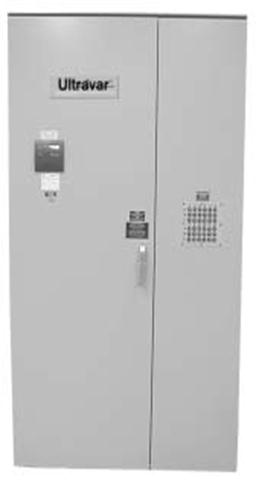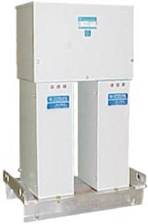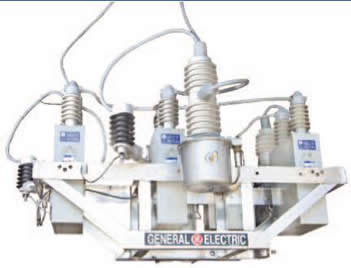| POWER FACTOR [’pau·’r ‚fak·t’r] -n A ratio of the apparent power delivered (kVA) and the actual amount of power used (kW). Power factor is an indication of efficiency. |

What can be done to improve my PF? For more information on harmonics click here. Designing a system of PF equipment is our forte and there are many things that need to be considered. It is important that it is done correctly to avoid costly errors or misapplication that can damage equipment. Below are some basics on the equipment. Additional information is in our Fixed Capacitor brochure (link?). We recommend and can provide the Ultravar PFC system built by General Electric and will assist you in the design of a system. 1. Fixed Capacitor Equipment. The most practical and economical power factor correction (PFC) device if applicable for your application. This type equipment can be used right on a large load or electrical sub-panel. The equipment EPower Factor utilizes is built by GE and is available from 208 volts to 35,000 volts at virtually any kVAr value. Click image to down load more info. 
The kVAr rating of a capacitor system indicates how much reactive power (capacity) the capacitor will supply. It is very important not to oversize the unit but you don't want to undersize it either. The properly sized PFC units can be installed at strategic point(s) in the electrical system and will improve the power factor between the point of application and the power source by storing and supplying this reactive current instead of requiring it continuously from the source. However, the power factor between the load and the capacitor will remain unchanged. Power factor correction systems in a large modern facility are usually installed at main services and/or sub stations at 208,204 or 480 volts. They can also be installed at the primary voltages for primary metered accounts either pole or pad mounted. 2. Switched Capacitors (automatic). Plants equipped with very large, intermittent inductive loads, such as large motors, production equipment, elevators compressors, etc., may require switched capacitors; that is, a capacitor system that is centrally located "downstream" from the utility metering equipment that automatically adjusts the kVAr amount. These systems are generally installed at the main electrical switch gear or outside on a pole or electrical pad. The systems continuously monitor the varying electrical demand load and add or subtract the appropriate capacitor steps (kVAr) as needed to maintain a steady target Power Factor at all electrical load levels, day, night and weekends. The automatic switching capacitors systems are commonly required so there is an undesirable leading power factor during times when facility loads are light. Click image to download catalog information 3. High Voltage Applications: This is an example of what a pole mounted GE Power Factor GE High Voltage Capacitor Units are recognized as “best in class,” having been designed to meet your diverse needs for increased durability and low field-failure rates. GE is the only manufacturer to produce its own HAZY* polypropylene dielectric film, which in conjunction with GE’s Dielektrol* fluid provides low power loss, superior rating to size performance, higher reliability, and lower operating costs. |
| Copyright © 2013 E Power Factor | 508.747.4744 | Sitemap |

 Correction System looks like. These systems may be the best choice if your electrical use is measured at the primary voltage level. This is when the local utility has there metering equipment ahead of the main transformer on the primary (High) voltage. This approach will not work if your electrical usage is measured on the low voltage (secondary) side of the main transformers. This approach can usually be installed without an electrical shutdown of the facility.
Correction System looks like. These systems may be the best choice if your electrical use is measured at the primary voltage level. This is when the local utility has there metering equipment ahead of the main transformer on the primary (High) voltage. This approach will not work if your electrical usage is measured on the low voltage (secondary) side of the main transformers. This approach can usually be installed without an electrical shutdown of the facility.